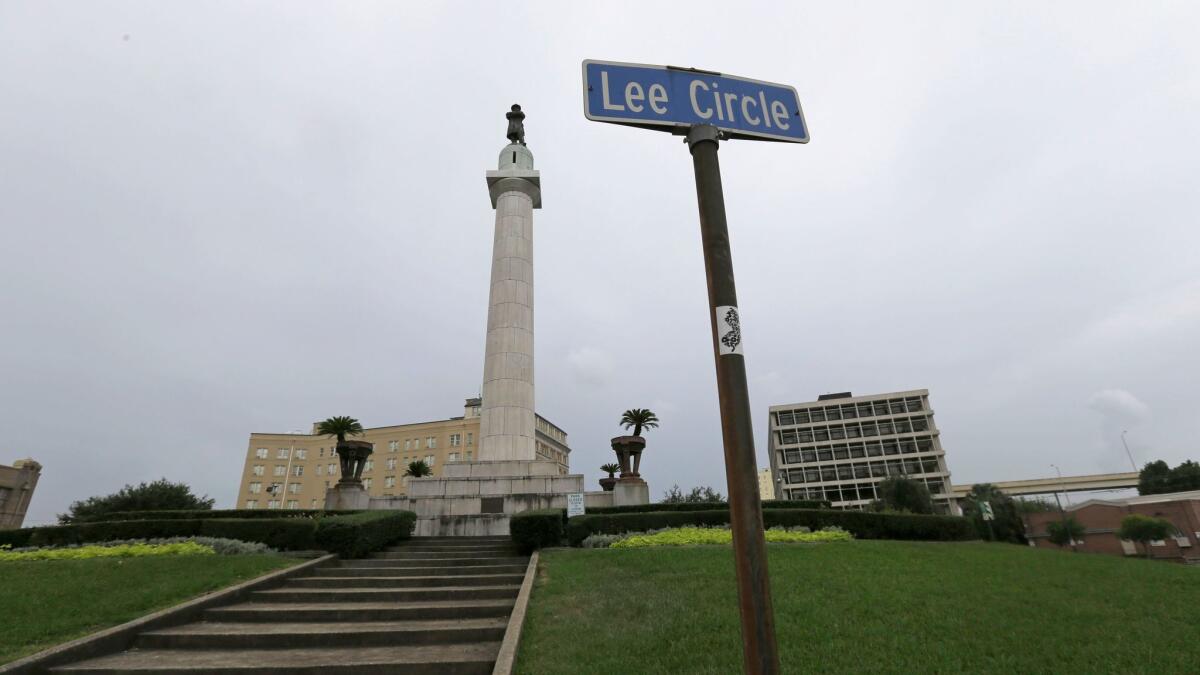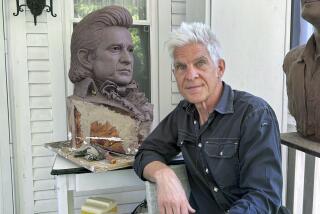Editorial: A monumental challenge: What to do about statues of the heroes of Dixie — and defenders of slavery

- Share via
It’s remarkable that 152 years after Gen. Robert E. Lee surrendered near Appomattox Court House in Virginia it is still necessary to point out that leaders in Southern states sparked the Civil War in hopes of creating a new, separate nation based upon white supremacy and slavery. Despite the assertions of apologists, the war was not a fight to repel Northern aggression — the South fired first — nor to save a genteel agrarian culture. Those who continue to romanticize antebellum Dixie willingly embrace a world and economy that found its meaning and value in the violent subjugation of another race.
So it’s a very good thing — if a trifle late — that local governments in the South have been re-evaluating their Civil War memorials, and removing installations that honor racism, oppression and hate. It’s also a commentary on our times that workers who last month dismantled New Orleans’ monument to the Battle of Liberty Place — an 1874 uprising by white supremacists to overthrow the city’s Reconstruction government — felt obliged to do so in the early morning hours, wearing masks and bulletproof vests, and under the protection of police sharpshooters.
Describing the installations as “public nuisances,” the New Orleans City Council also ordered the removal of statues of Lee, who resigned his U.S. Army commission at the time of Virginia’s secession and accepted command of the state’s military forces; Pierre G.T. Beauregard, who oversaw the shelling of Ft. Sumter that launched the war; and Jefferson Davis, the U.S. secretary of war under President Franklin Pierce who became president of the Confederate States of America (and avoided a trial on treason charges under an amnesty granted by President Andrew Johnson). All three rebels were unapologetic defenders of slavery before, during and after the war, though Beauregard eventually came to accept equal rights.
The sins of our fathers must be acknowledged. They should not be hidden or mischaracterized or glamorized.
The impetus for this latest round of Southern soul-searching was the June 2015 murder of nine African American churchgoers in South Carolina by Dylann Roof, whose intent, he told police, was to foment a race war. Photos quickly turned up of Roof holding the Confederate battle flag, and abashed political and community leaders quickly began efforts to remove that flag from public buildings — including, for instance, from the grounds of the South Carolina Statehouse in Columbia. But many of the public memorials to leaders of the rebellion remain.
The nation still grapples with slavery’s legacy, from crass daily outbursts of racism to its subtler manifestations in housing patterns, economics, schools, politics and culture. Roof and his ilk continue to exist in part because of the miscasting of Civil War history; the longer that portions of the nation cling to a skewed narrative of the past, the longer it will take for the nation to fully realize where it came from, and where it is.
Removing public monuments to slavery’s leading defenders is not an effort to rewrite history. There’s a difference between recognizing, studying and understanding history, and celebrating its most egregious actors. Lee, Davis, Beauregard and others would hardly be known today had they not taken up arms against the federal government to protect the institution of slavery. Yes, George Washington and Thomas Jefferson also owned slaves, but their roles in American history were built on other things. That’s not the case with the heroes of the Confederacy.
It’s true that the North and its leaders were not above reproach either. New England ships carried kidnapped Africans into slavery. Northern mills spun slave-grown cotton into textiles. New York financiers grew wealthy from investing in the plantation economy. Northerners, led by the religion-based abolitionist movement, may have had earlier epiphanies about the evil of the slavery system than Southerners, but the birth and growth of the United States is inextricably connected to the slave economy — a horrific system that enriched white America by making chattel of fellow human beings under the assertion that their race made them inferior.
The sins of our fathers must be acknowledged. They should not be hidden or mischaracterized or glamorized. In an era of alternative facts, where the truth of the present can be hard to ascertain, it is all the more incumbent on us to make sure we affirm the truth of the past.
Follow the Opinion section on Twitter @latimesopinion or Facebook
More to Read
A cure for the common opinion
Get thought-provoking perspectives with our weekly newsletter.
You may occasionally receive promotional content from the Los Angeles Times.










